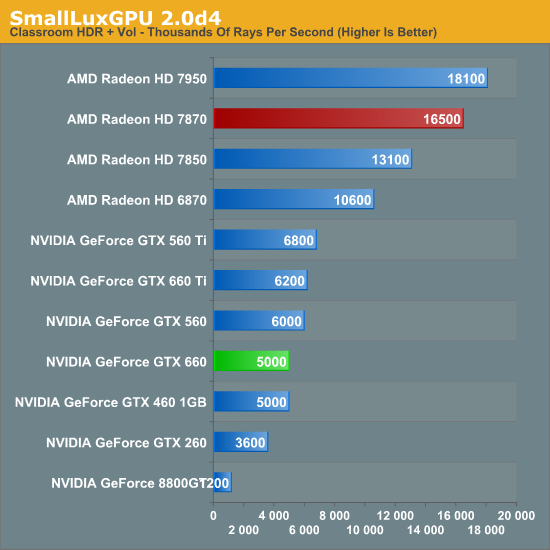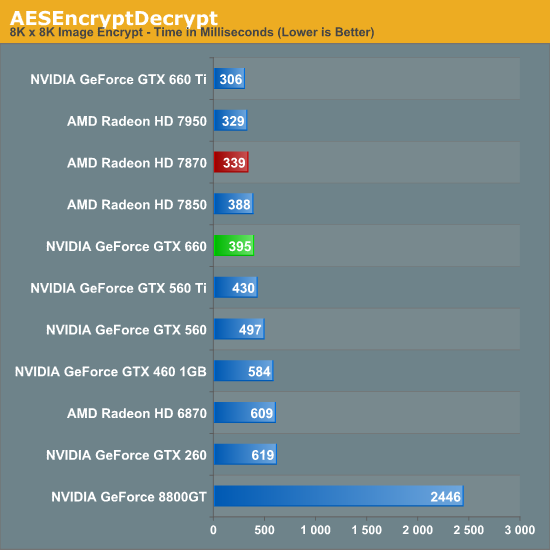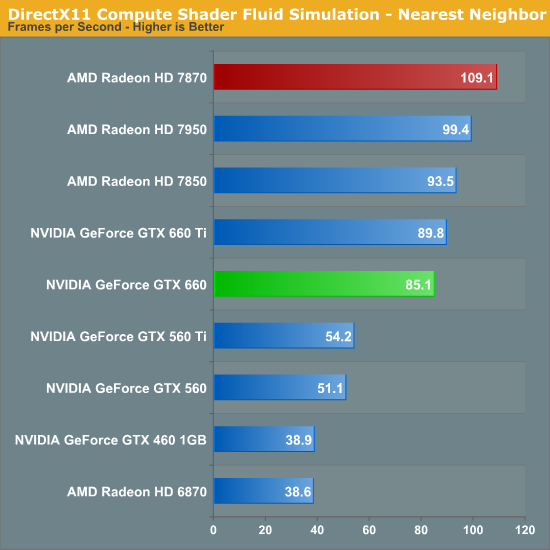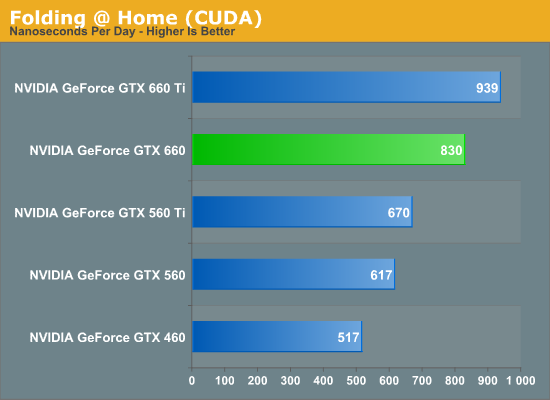The NVIDIA GeForce GTX 660 Review: GK106 Fills Out The Kepler Family
by Ryan Smith on September 13, 2012 9:00 AM ESTCompute Performance
As always our final set of real-world benchmarks is composed of a look at compute performance. As we have seen with GTX 680 and GTX 670, Kepler appears to be significantly less balanced between rendering and compute performance than GF110 or GF114 were, and as a result compute performance suffers. Further compounding this is the fact that GK106 only has 5 SMXes versus the 8 SMXes of GK104, which will likely further depress compute performance.
Our first compute benchmark comes from Civilization V, which uses DirectCompute to decompress textures on the fly. Civ V includes a sub-benchmark that exclusively tests the speed of their texture decompression algorithm by repeatedly decompressing the textures required for one of the game’s leader scenes. Note that this is a DX11 DirectCompute benchmark.

It’s interesting then that despite the obvious difference between the GTX 660 and GTX 660 Ti in theoretical compute performance, the GTX 660 actually beats the GTX 660 Ti here. Despite being a compute benchmark, Civlization V’s texture decompression benchmark is more sensitive to memory bandwidth and cache performance than it is shader performance, giving us the results we see above. Given the GTX 660 Ti’s poor showing in this benchmark this is a good thing for NVIDIA since this means they don’t fall any farther behind. Still, the GTX 660 is effectively tied with the 7850 and well behind the 7870.
Our next benchmark is SmallLuxGPU, the GPU ray tracing branch of the open source LuxRender renderer. We’re now using a development build from the version 2.0 branch, and we’ve moved on to a more complex scene that hopefully will provide a greater challenge to our GPUs.

SmallLuxGPU sees us shift towards an emphasis on pure compute performance, which of course is going to be GTX 660’s weak point here. Over 2 years after the launch of the GTX 460 and SLG performance has gone exactly nowhere, with the GTX 460 and GTX 660 turning in the same exact scores. Thank goodness the 8800GT is terrible at this benchmark, otherwise the GTX 660 would be in particularly bad shape.
It goes without saying that with the GTX 660’s poor compute performance here, the 7800 series is well in the lead. The 7870 more than trebles the GTX 660’s performance, an indisputable victory if there ever was one.
For our next benchmark we’re looking at AESEncryptDecrypt, an OpenCL AES encryption routine that AES encrypts/decrypts an 8K x 8K pixel square image file. The results of this benchmark are the average time to encrypt the image over a number of iterations of the AES cypher.

Our AES benchmark was one of the few compute benchmarks where the GTX 660 Ti had any kind of lead, but the significant loss of compute resources has erased that for the GTX 660. At 395ms it’s a hair slower than the 7850, never mind the 7870.
For our next benchmark we’re looking at AESEncryptDecrypt, an OpenCL AES encryption routine that AES encrypts/decrypts an 8K x 8K pixel square image file. The results of this benchmark are the average time to encrypt the image over a number of iterations of the AES cypher.

The fluid simulation is another benchmark that includes a stronger mix of memory bandwidth and cache rather than being purely dependent on compute resources. As a result the GTX 660 still trails the GTX 660 Ti, but by a great amount. Even so, the GTX 660 is no match for the 7800 series.
Finally, we’re adding one last benchmark to our compute run. NVIDIA and the Folding@Home group have sent over a benchmarkable version of the client with preliminary optimizations for Kepler. Folding@Home and similar initiatives are still one of the most popular consumer compute workloads, so it’s something NVIDIA wants their GPUs to do well at.

As we’ve seen previously with GK104, this is one of the few compute benchmarks that shows any kind of significant performance advantage for Little Kepler compared to Little Fermi. GTX 660 drops by 12% compared to GTX 660 Ti, but this is still good enough for a 60% performance advantage over GTX 460.










147 Comments
View All Comments
Galidou - Thursday, September 20, 2012 - link
Whenever I see CeriseCogburn commenting, Chizow is not, and vice versa....If you never heard about price fixing, sorry for you but it's a fact, THAT is a fact, people don't have to beleive in that, it's happening right now and always has been and beleive me it will continue, because almost every company in the world is greedy even if it means communicating with the competition to maximize profit....
CeriseCogburn - Thursday, November 29, 2012 - link
Gal, you silly gal, Chizow knows a lot more than I do, but I'll say this, you're an insane and incorrect amd fanboy of the worst kind.I hope david's butt remains a delicacy to you, even after the corpse is buried, which is, by the way, to happen, very soon.
CeriseCogburn - Thursday, November 29, 2012 - link
Galidou, you win NOTHING for being a lying sack, then whining when someone is so sick of your complete bs, they offend your idiot retarded estrogen doused amd licking being because they aren't a sick lying gasbag biased amd pig.Glad that religious Bible story has you kissing david amd's tokus furiously though, as that surely commands respect.
LOL
NOT !
Oh, were you insulted ?
Let's hope so, because of course, you tell so many lies, it's IMPOSSIBLE for you to not be insulted.
rarson - Tuesday, September 18, 2012 - link
AMD's pricing doesn't need to be defended because anyone with a grasp of basic economics can easily understand why they priced them the way they did. That's why most people are ignoring your inane and mind-bogglingly stupid comments."How do you feel now about those $550, $450, and $350 pricepoints you so vigorously defended when the 7970/7950/7870 launched?"
Absolutely fine, dumbass, because it's September now. Duh.
"So just as I asked then"
Nobody cares, dude. Go fanboy somewhere else.
chizow - Tuesday, September 18, 2012 - link
Yes anyone with a basic grasp of economics would never have defended the worst increase in price and performance in the last decade and then be OK with the biggest price drop in the least amount of time within the same generation. AMD now holds the notorious distinction for both and their fanboys (like you) get to suffer the consequences.How much did the GTX 580 cost 15 months after release? $500 still dumbass, duh, now go fanboy somewhere else? Parts like this don't lose their value unless they suck, or their pricing sucks, or both, but obviously you're too oblivious or stupid to realize this, or maybe you're just accustomed to it as an AMD fan.
CeriseCogburn - Thursday, November 29, 2012 - link
You're an idiot.AMD cost me plenty, and I will NEVER fall for your stupid amd lies, ever again.
Klimax - Saturday, September 15, 2012 - link
A thing: Dirt Showdown is AMD game using DC codepath optimised ONLY for Radeons severly penalising nVidia's cards. It is not valid for any comparsions.(At least not with that option enabled)
chizow - Thursday, September 13, 2012 - link
Just wondered if there was any news about price drops for higher-end SKUs. It becomes more obvious with every newly released SKU that the original asking prices from both AMD and Nvidia on 28nm parts were far too high. $350 for a 7870 looks like a complete debacle at this point given a $229 part outperforms it just a few months later.Also it looks like the Summer 2012 GPU pricing chart needs to be adjusted for the GTX 660 (it shows $239).
Thanks for the commentary on page 3 about Nvidia's Competition. Much like Intel, they still need to compete with themselves to entice owners of their previous products to upgrade. I'm glad someone else gets it, its pretty obvious Nvidia does as well. I guess they heard the complaints of all their enthusiasts when asking $500 flagship dollars for a part based on a midrange ASIC.
RussianSensation - Thursday, September 13, 2012 - link
A couple months?HD7850 - $249 March 3, 2012
HD7870 - $349 March 3, 2012
GTX660 - $229 September 13, 2012
It's been 7 months.
Someone who bought an HD7850 and OCed it enjoyed ~ GTX580 / HD7950 level of performance for 7 months now. Using the same exact logic you have just outlined, then we should recommend people to wait 7 more months for HD8000 series and skip GTX660 because for them the 660 would be an "early adopter" premium vs. HD8870. See how illogical your comment is?
GPUs often drop in price over time as the generation goes on.
Interesting how GTX280 for $649 and GTX260 $399 weren't a problem for you.
chizow - Thursday, September 13, 2012 - link
Except we've already covered this pricing debacle months ago, pretty sure you were onboard then, what happened since then?The 7870 was already vastly overpriced because it offered 6970/GTX 570 at.....6970 and GTX 570 prices. Parts that were already widely available for at least 20 months prior to the 7870's launch at the exact same prices. Anyone who already had that performance level would have no incentive to sidegrade to a 7870 at that pricepoint.
What is obvious now as it was then is that there was no movement in terms of price:performance that you would expect from a new generation, the metric didn't shift at all for 28nm until Kepler launched. Now that Kepler has finally trickled down to this performance level, its that much more clear. Bringing your 8870 argument into the fold, I wouldn't agree with that view either as I would expect the 8870 to offer more performance at a lower pricepoint, not the same performance at the same price as is the case with the 7870 at launch.
I don't know why you're trying to defend AMD's horrid 28nm pricing but the fact of the matter is, the current pricing structure is really what 28nm should have been from the outset, anyone who bought in March and didn't actually need a new GPU is undoubtedly feeling the burn of all the recent price drops, but hey, at least its not as bad as Facebook's IPO?
And no, GTX 260/280 weren't a problem for me because the difference is with those parts, the performance justified the premium relative to the last generation of cards (8800GT/GTX). This generation clearly does not adhere to those same expectations, which again, is a view I'm pretty sure you were onboard with months ago. What Nvidia didn't expect was for AMD to lowball them so much on a certain performance level, something AMD has clearly worked to remedy with each successive generation with their increases in asking prices for their 1st and 2nd tier single-GPU SKUs.